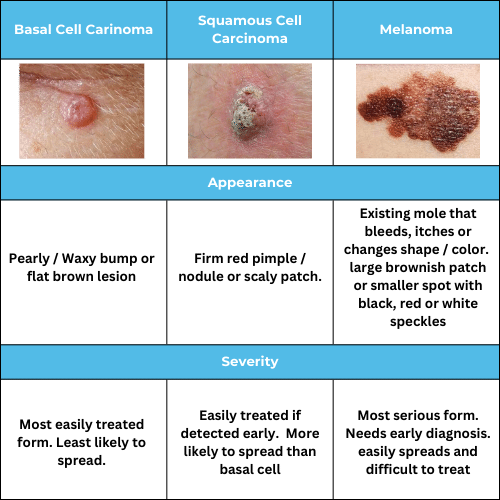Self-Screening Exams - Skin Cancer
Skin cancer is an extremely common problem today. Here we will discuss how patients can perform self-assessments, why they are important, how often they should be done, and other useful information.
Understanding Skin Cancer
1. What is Skin Cancer?
Skin cancer is a general term for cancer that originates in the skin. They come in a variety of different types and subclasses. In general, however, there are 3 main types of cancers - Basal Cell Carcinoma, Squamous Cell Carcinoma, and Melanoma. There are of course more and an entire specialization of medicine regarding this, but for the non-medical person, these are the 3 types to be aware of. They have distinctive looks and characteristics that can easily be seen even by non-medical people.
2. What are the differences between skin cancers?
For a non-medical professional, the differences between skin cancers basically come down to is it melanoma or not melanoma. While it matters to us professionals the differences between basal cell and squamous cell, to a patient the only thing that matters is: is it cancer, and if so, is it melanoma?
The reason for this is that Basal Cell and Squamous Cell cancers are generally slower-growing and less invasive. Basal cells especially can take months and years to develop. Cancers of these types can often be treated by simple extraction, or even freezing it off as it takes soo long before it moves into lymph nodes and becomes dangerous to a patient. That’s not to say that they are not dangerous, they are still cancer and left unchecked they will become very dangerous, it just takes time to get to that point.
Melanoma is something different entirely. Melanoma can rapidly invade the tissues, lymph nodes and spread throughout the body in a process known as Metastasis. No time can be wasted in treatment and it is imperative that it be treated early before it progresses. Melanoma is extremely fatal if not caught early.
3. Does skin cancer have symptoms?
In general, skin cancers develop as superficial lesions and that is it. Sometimes they will bleed, and sometimes they will itch which may prompt a patient to look at it, but a majority of the time they can develop completely unnoticed until someone actually looks at it. This is why it is important for patients to perform self-exams regularly to check for lesions that are developing and catch them before symptoms emerge. Once major symptoms emerge it is often extremely difficult to treat.
4. How often should I perform a self-exam?
In general, self-assessments should be performed at least annually, preferably every 6 months. Depending on your risk factors, family history, and other things will dictate whether you should do them more frequently than that. High-risk patients should always have annual assessments with a qualified medical provider and self-assessments could be done between checkups
5. What do I look for?
As non-medical professionals, patients do not need to know and be able to identify exactly what cancer looks like. The point of doing self-assessments is to have a thorough understanding and feel for what your body’s normal is. Most people are not aware of all the different moles, freckles, or lesions that are present on all of the surfaces of their body and the point of this is to become aware of them. By doing this regularly, you will notice when a lesion changes, if it became darker, got larger, has become more irregularly shaped than it used to be, or even if the lesion is new. The point of doing regular self-assessments is to look at your skin on every surface and identify any lesions. If any of them appear suspicious to you, make an appointment with a healthcare provider to make an assessment and answer any questions you have.
All that being said, here are a few examples of common appearing cancers. Remember that dermatology is a field of medicine that takes decades to master, the rule of thumb is to have a healthcare provider tell you what is normal and all you need to do is look for new lesions or changes in lesions.
The Self-Skin Exam
*The following recommendations and graphics are from the American Cancer Society Please visit their website if needed for additional information
Front
1. Check your face, ears, neck, chest, and belly. Women will need to lift their breasts to check the skin underneath.
Upper Extremities
2. Check your underarm areas, both sides of your arms, the tops, and palms of your hands, in between your fingers, and under your fingernails.
Back
3. Use a comb or hair dryer to part your hair so that you can check your scalp.
Lower Extremities
4. Check the front of your thighs, shins, tops of your feet, in between your toes, and under your toenails.
Bottom
5. Now use a hand mirror to look at the bottoms of your feet, your calves, and the backs of your thighs, first checking one leg and then the other.
Remainder
6. Use the hand mirror to check your buttocks, genital area, lower and upper back, and the back of your neck and ears. Or it may be easier to look at your back in the wall mirror using a hand mirror.
What to do if you find a suspicious lesion
If you have located a lesion that was suspicious to you, step one is to grab a ruler and take a high-quality photo of it. This photo should be clear without any signs of blurriness. Step two is to schedule an appointment to see your healthcare provider for evaluation. To learn more about Starlight Health or to schedule a consultation please check out our main page!







